Whether you’ve shattered a glass while washing it or a decorative glass item has fallen from a kitchen shelf, having tiny pieces of glass in your sink can be a difficult problem to tackle. As long as you don’t try to wash the glass down the drain, you can fix this using over a dozen methods of removing broken glass in your sink.
To pick up broken glass in the sink, you must let the water drain, then use a broom to sweep up the larger shards and a damp paper towel to retrieve the smaller bits. Once the sink surface is clear, it is optional to remove the U-bend under the sink and get the glass shards out of it.
In this article, you will learn how to pick up broken glass in the sink using 9 different ways, including:
- Remove large glass pieces with a broom or dustpan
- Use a damp paper towel to remove small glass bits
- Use bread to remove medium-sized glass bits
- Use a potato to remove sharp glass bits
- Remove the U-bend under the sink and empty it
- Use nose pliers or a sink grabber to remove shards from the U-bend
- Use running water to remove the rest of the shards
- Use a lint roller to clear out the glass from the surface
- Use masking tape to remove the remaining glass from the surface
I decided to try these common methods to see if they were myths or legends. I got some surprising results!
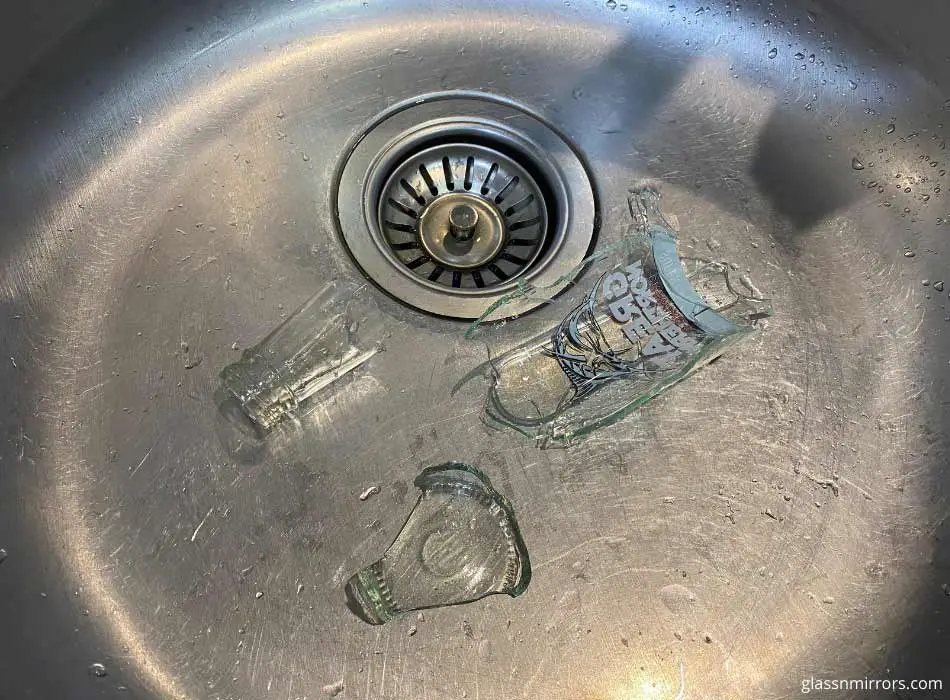
Table of Contents
- 1 Use A Broom And A Dustpan
- 2 Use a Wet Paper Towel
- 3 Use Bread to Clear the Pieces
- 4 Use A Potato
- 5 Tiny Glass Removal Methods Compared
- 6 Remove The U-bend And Retrieve Glass Shards
- 7 Turn the Bend Upside Down and Empty It
- 8 Use a Grabber Tool to Remove Any Pieces That Are Stuck
- 9 Use Water to Remove the Remaining Shards
- 10 Use a Lint Roller (Tape Variety) To Clean the Sink Surface
- 11 Use the Sticky Side of a Masking Tape to Retrieve Shards
- 12 FAQs About Removing Glass From the Sink
- 13 Hot Glass vs Cold Glass – What’s The Difference?
- 14 Can Quartz Be Made Into Glass? Guide On Quartz & Glass
- 15 What Is Panda Glass | Ultimate Guide To Panda Glass
Use A Broom And A Dustpan
The most obvious way to remove glass shards from the sink is to use a broom and a dustpan, but it works for large pieces only. Since the larger shards are the most dangerous ones, this step is quite crucial.
This will be easier without the sink water, so let that drain. I also explain here; does broken glass float in water?
The smaller pieces need to be picked up as well, but the pieces you do not want to go down the drain are usually the ones that can get stuck at a point along your plumbing.
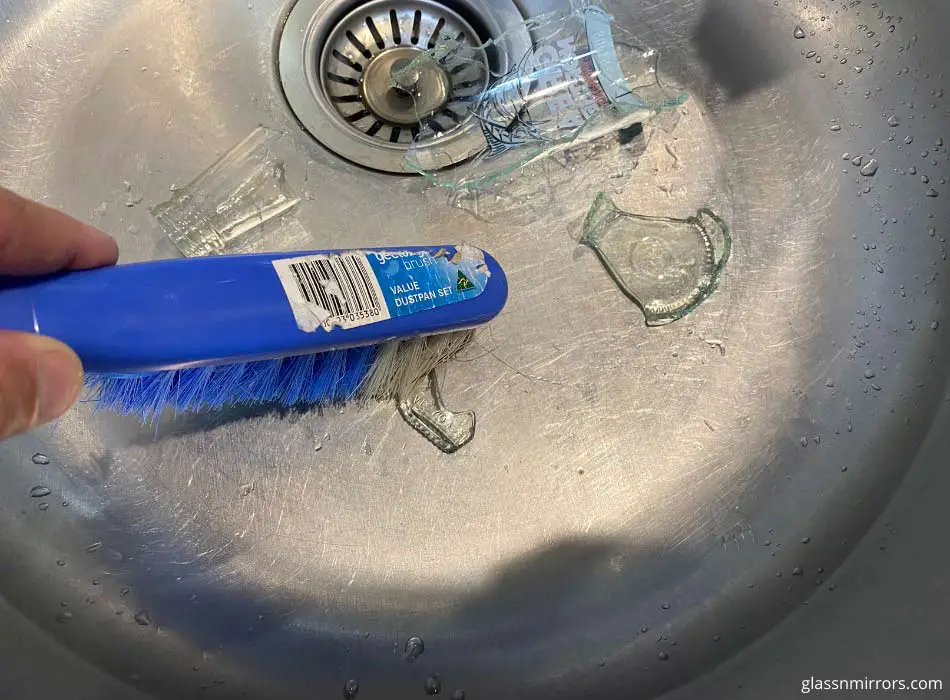
You should then carefully remove larger pieces by sweeping them into a dustpan with a hand brush or a short broom. Some pieces can be removed more easily by hand. I did not dedicate a section to hand-picking because the answer is too obvious.
More importantly, you may have already removed the largest pieces by hand. If you have not, then remember to wear gloves when you extract broken glass and pick up the portions that are too large for a broom.
Glass shards in your hand can be dangerous. See my article Can a piece of glass travel through the body?
Use a Wet Paper Towel
With the largest pieces out of the way, it is time to remove the smaller shards that populate your sink. These are usually too small to get picked up by a broom but not small enough to be dismissed altogether.
While they do not pose as big of a risk to your drainage system, they make washing dishes riskier. Spoons and dishes get left in the sink without much thought. Having tiny glass shards stick to their surface can pose a serious health risk, so you have to remove the smallest pieces of glass.
You could use water to wash it down but doing so at this stage could worsen the situation for the larger pieces that may have gone down the sink drain already. Until you have removed those, you must not use running water.
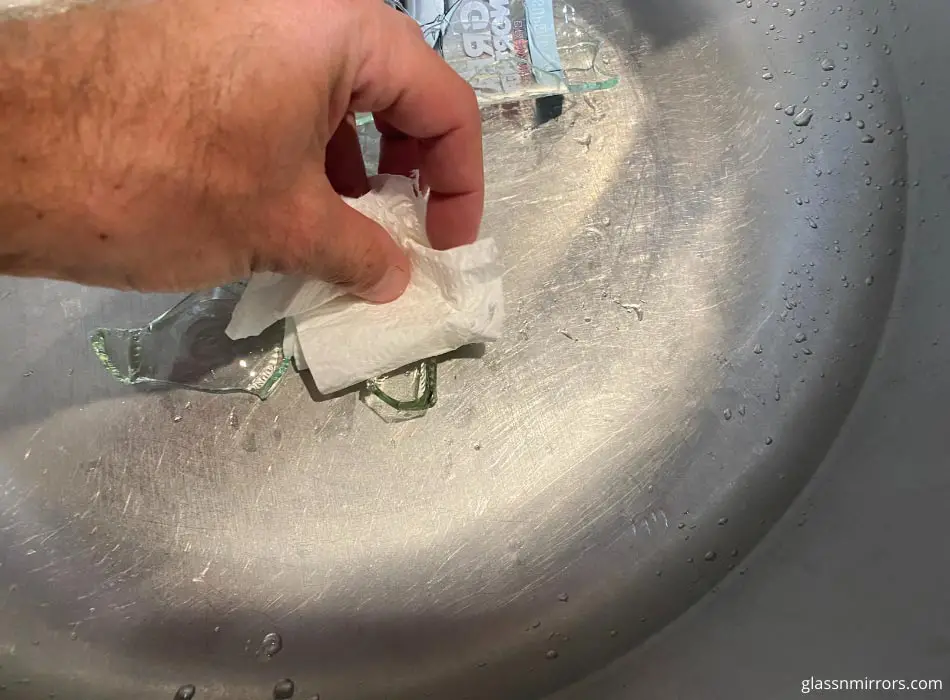
So, how does one remove barely visible glass shards without washing them down the sink drain? The same way one would remove them from the floor. One of the most common ways to remove tiny glass pieces is with a wet paper towel.
Take a large paper towel and roll it in multiple layers. Dampen it, then press it against a portion of the sink’s surface. Do so a few times, then dispose of the paper towel and get a fresh sheet.
I found you will need to be very careful as the sharp pieces of glass can cut through the paper towel quite easily. It does work quite well though.
Use Bread to Clear the Pieces
If the paper towel method looks too dangerous or you just don’t want to run out of paper towels, you can use bread to the same effect. Bread helps pick up tiny shards that your broom may have missed, but it can miss out on tinier pieces that are smaller than the bread holes.
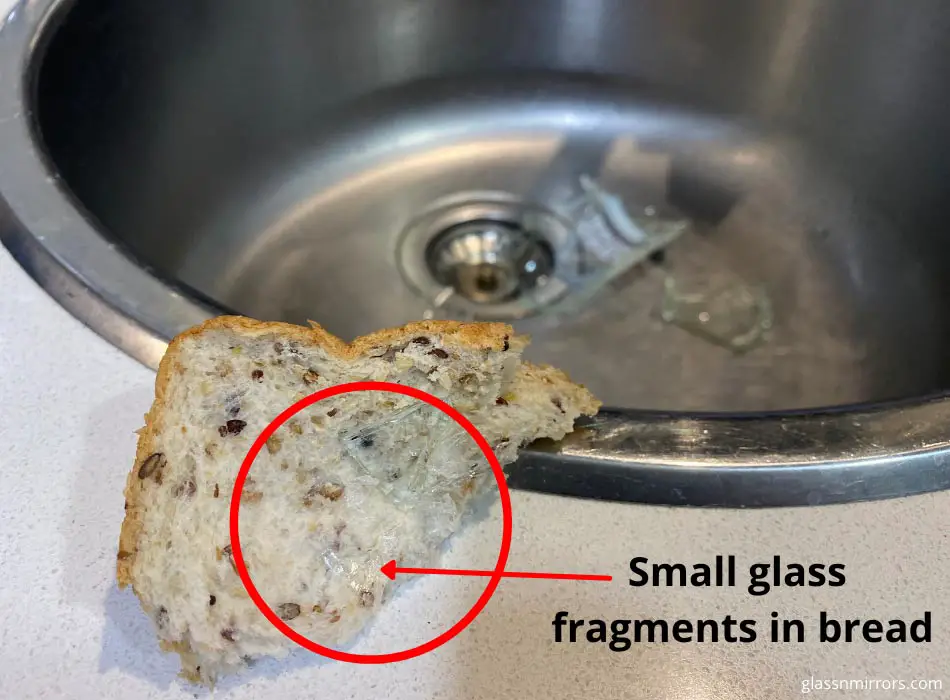
It is also risky to use bread because the slice requires more pressure to grip glass pieces, and given how any piece can puncture through the bread, your hand remains at risk throughout the cleaning session. More importantly, this cleaning method costs a lot. One slice of bread clears three slices’ worth of area in the sink. That equates to a dozen slices going, pardon the pun, down the drain.
I did find that this method worked very well. You only need to apply gentle pressure and you can pick up the smallest of glass pieces. You don’t have to pinch the bread to grip them either.
Small pieces of glass seem
to stick on the bread fibres easily!
If this method is less safe than a wet paper towel and costs more, why is it even included? Because using a bread slice to clear glass doesn’t require you to make the sink wet. As mentioned earlier, you do not want the glass shards wet and slippery, so water in the sink must be minimized until you’re ready to clear the plumbing.
In general glass-picking, the bread method allows one to get heavier chunks that would fall off if retrieved with a paper towel, but that advantage does not apply here because you’ve already used a broom to remove those pieces.
Use A Potato
If the comparison between the paper towel method and the bread method is a little confusing, a potato comes as the clear winner. Not only is a potato more effective at picking shards of the most diverse sizes, but it is also safer for your palms.
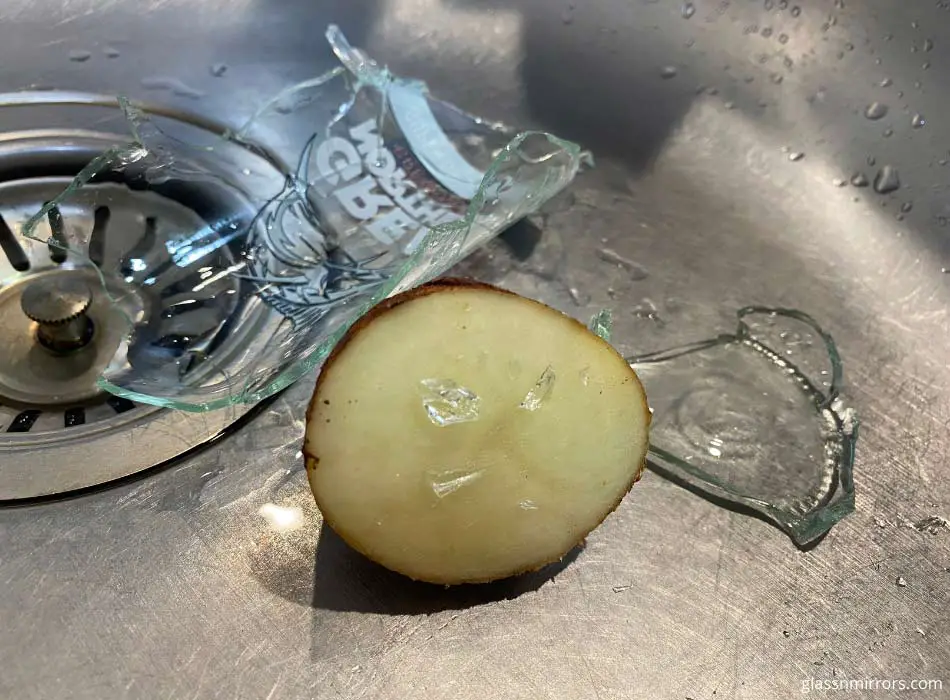
You will just need a potato cut in half and that’s it! The small pieces of glass stick very well to the potato.
Press it down gently until glass shards stick to it. You might have the urge to press down hard, but that’s not required. Even touching the potato’s surface makes glass pieces stick.
Tiny Glass Removal Methods Compared
If you’ve skimmed through the three sections above or are simply unsure as to which you should use, the following table will help you decide which method fits your situation. Remember, you can always use a combination of these.
| Use a damp paper towel if: | Use a slice of bread if: | Use a potato if: |
|---|---|---|
| The glass pieces are barely visible | The glass pieces are visible but can’t be broomed onto a dustpan | The glass pieces are a mix of barely visible and sharp, noticeable bits |
| You have paper towels nearby | You have old bread you don’t need | You have potatoes lying around. |
| Your sink covers a large area | You have a relatively small sink | Your sink’s plugholes are small, which creates a broad mix of glass pieces that get left behind |
| If you have a pair of gloves | If no piece of glass is bigger than the breadth of the slice | If you don’t have gloves |
If you want to use all three methods, the best sequence is as follows
- Use the potato first, so the widest range of glass shards is cleared first.
- Then use the bread to remove the largest remaining pieces
- Finally, use the damp paper towel to remove pieces that you can barely notice.
After this, you’re ready to deal with the pieces that have gone down the plughole.
Remove The U-bend And Retrieve Glass Shards
Only do this step if you are sure that larger pieces of glass have gone down the plughole. If you are not confident in doing this, call a licensed plumber.
In the rare case where the plughole is removed, large pieces of glass that can damage the kitchen plumbing end up in the U-bend. Usually, pieces smaller than the individual holes in the plug go down the sink.
In either case, you will need to remove the U-bend (or the P-trap) under your sink and clean out the glass pieces lodged there. There are a few ways to remove the glass from the u-bend underneath your sink.
Turn the Bend Upside Down and Empty It
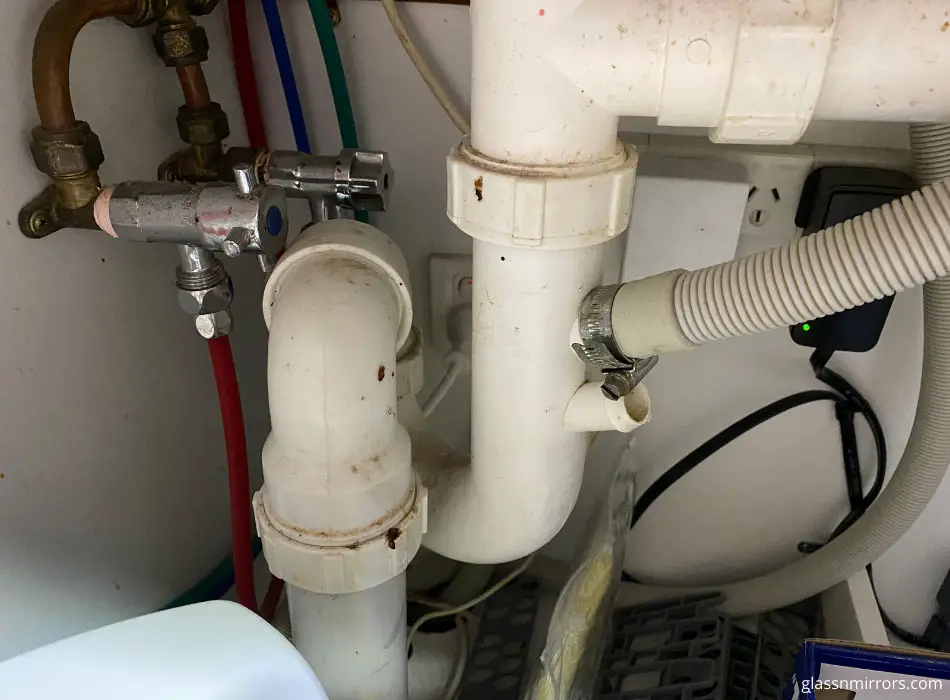
Once you have removed the P-trap, you can empty its contents into a dustpan or a bucket. The P-trap can often contain liquid, making dustpans suboptimal for emptying their contents, but if you see only glass shards with no water, you can clean out the trap over a flat dustpan. Any disposable container works for this step. It is the next one that’s quite tricky.
Use a Grabber Tool to Remove Any Pieces That Are Stuck
Whether you’re using a sink grabber tool to reach into the sink drain or using a nose plier to remove pieces lodged in a U-bend that is already detached from the sink, you’re in the final stages of glass removal from your sink.
When you turn the bend upside down, you might notice that not all glass pieces come out. If that’s the case, you are dealing with dangerous pieces that can harm the kitchen plumbing.
Use Water to Remove the Remaining Shards
Once the P-trap is removed, you should place an empty bucket under it and let the water run freely. This forces glass pieces that are in the sink, albeit far from the U-bend to watch through. Since the bend is removed, they will not get caught or move onto the kitchen plumbing.
Instead, they will drop into the bucket. This leads to another problem: how does one dispose of the water that has pieces of glass floating in it. We will cover disposal in the final section of this article.
Use a Lint Roller (Tape Variety) To Clean the Sink Surface
Once you have cleared the sink with running water, you need to do one final sweep of its surface, just to make sure that there are no glass bits that might get onto your plates and dishes.
Here, you need to use a method that clears the surface of the tiniest glass pieces. If you have a common lint-roller that features an adhesive strip, you can use it to clear the surface after the sink is completely dry.
Use the Sticky Side of a Masking Tape to Retrieve Shards
Alternatively, you can crumple up a long strip of masking tape so that its adhesive side is facing outwards and roll it across the sink’s dry surface for a while. This will get rid of the tiniest shards of glass that most people cannot usually see.
FAQs About Removing Glass From the Sink
Can I Use a Vacuum to Remove Glass?
You cannot use a vacuum to remove glass because glass bits can damage the filter bag and the vacuum cleaner’s pipe. Opt for safer methods like brooming the area or using masking tape to remove tiny pieces of glass.
Can Broken Glass Go Down the Drain?
Broken glass can go down the drain with enough force but in most cases, gets lodged in the pipes. On average, glass bits that pass through a plughole are too small to get stuck or do any damage to the plumbing.
How Can I Dispose of Glass After Collecting It?
You can put dry glass bits in a garbage bag and place the bag inside two other garbage bags for added security. For a mix of water and tiny bits of glass, you can drain the water through a sieve, and put the bits in recycling.
-
Hot Glass vs Cold Glass – What’s The Difference?

When most people think of glass, they probably think of windows or drinking glasses. But there is a lot more to glass than that. In fact, there are two main … Keep Reading
-
Can Quartz Be Made Into Glass? Guide On Quartz & Glass
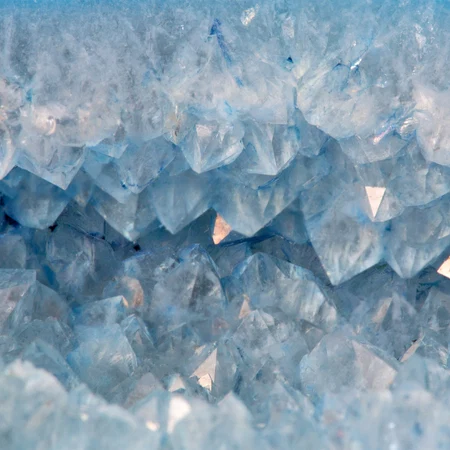
Glass making is a process that involves heating and cooling sand and other minerals. You may wonder whether it is possible to make glass out of quartz. Glass is made … Keep Reading
-
What Is Panda Glass | Ultimate Guide To Panda Glass

When looking for a new phone case, you may have encountered the term “panda glass.” A variety of phone cases on the market use this type of glass. But what … Keep Reading

2 thoughts on “9 Ways To Pick Up Broken Glass From Your Sink”
Comments are closed.